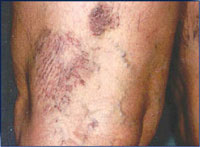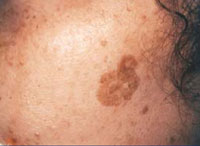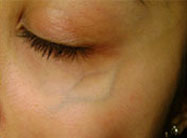The development of lasers, and more recently IPL, LHE, and LED systems, has allowed practitioners to treat certain types of vascular (vein) and pigmented (skin colour) lesions more safely and effectively. Different light systems may be used to treat a range of different vascular and pigmented problems including: spider or thread veins, port wine stains, rosacea, spider naevus, age or liver spots, solar keratosis, freckles, pigmented birthmarks, warts, verrucae, some scars and stretch marks. Because of the variety of different skin problems that can be treated with these machines we cannot stress strongly enough how important it is to find a practitioner experienced in treating your particular problem. Treatment costs vary depending on the type and extent of the problem that you have. Prices for minor treatments involving small areas may cost in the region of $80 per session, with intermediate treatments being around $250 – $380 and major treatments $500 or more per session.
Pro Yellow, Schlerotherapy & Telangitron - Pigmented & Vascular Problems

Find Out More
Discover Telangitron
The Telangitron is a versatile machine used to treat small capillaries, rosacea, skin tags and other skin growths. It is subtle, quick and does not leave the skin damaged at all. Try this before any lasers as you will find amazing results and once treated the area is much clearer and without the high cost of laser treatments which tend to be harsher. With over 30 years of experience with this machine, we have had excellent results!
Pro Yellow 570
Pro Yellow is indicated for the removal of benign, pigmented lesions, such as age spots, stubborn capillaries, spider veins and more.
Laser & IPL Treatment for Pigmented & Vascular Problems background information
The use of light as a medical treatment has grown significantly in recent years. There are now a number of devices which can deliver different types of light for an ever-increasing array of new cosmetic uses.
Ultra – Violet light, for example, has been used to treat psoriasis (a skin disease) for a number of years, and many people use light boxes during the winter to reduce the symptoms of seasonal adjustment disorder (SAD). To put it simply, exposure to light, which resembles sunlight, makes people feel better!
The use of laser light for medical procedures began in the 1960s when they were first used in operations as cutting tools by some surgeons.
Laser technology has developed over the last few decades to treat patients with a variety of different skin problems including the effects of sun damage, removal of body hair and recently the treatment of psoriasis and acne.
Lasers are also commonly used by ophthalmologists (eye specialists) for the treatment of certain eye conditions, and there are now numerous private centres advertising the use of lasers as a treatment for short sightedness.
The use of lasers by cosmetic clinics has increased dramatically over the last decade. Newly invented laser machines can give you excellent results and without the former complications in recovery and healing.
More recently still, is the development of Intense Pulsed Light (IPL) and Light Heat Energy (LHE) systems that can be more flexible in use than some lasers.
Figures from the American Society for Aesthetic Plastic Surgery (A.S.A.P.S.) indicate that laser treatment of leg veins was performed just over 61,500 times in the U.S. in 2013, showing a large decrease of 45.5% since 2012.
If you are considering this procedure, the following information will give you a basic understanding about what’s involved. It can’t answer all your questions, since a lot depends on the individual patient and the practitioner. Please ask a practitioner about anything you don’t understand.
What are lasers and IPL/LHE/LED machines and how do they work?
Lasers
A laser is a high energy beam of light that can precisely transfer this energy into certain tissues within the skin. These beams of light are produced in one wavelength or colour at a time, and can vary in terms of their strength and the type of tissue that they can target.
Lasers used on a variety of veins or pigmented (discoloured) skin problems can direct their heat towards a desired target in the skin which results in “damage” to particular tissues. For example, in the case of thread (spider or red) veins, the target is the blood filled vessel that is precisely heated and destroyed by the laser without harming surrounding areas.
Intense Pulsed Light (IPL)
Intense Pulsed Light systems differ from lasers in that they can deliver hundreds of wavelengths (or colours) in each burst of light. Certain filters are used that target these flashes of light so that they work in a similar way to lasers causing heat damage to the particular skin problem.
The process of directing a laser or IPL source to a target area of the skin to damage it is technically known as “selective photothermolysis”. Your practitioner may refer to it as this.
Light, Heat Energy (LHE)
This is another light technique variation that sends out controlled levels of both low level light and heat.
Light Emitting Diode (LED)
Emits red light used in conjunction with special creams for the treatment of actinic keratosis and blue light for acne treatment.
What can they be used to treat?
Different light systems may be used to treat a range of different vascular (vein) and pigmented (skin colour) problems which may include:
- Telangiectasias – spider or thread veins -on the face or body;
- Port wine stains – (pink, deep red or purple patches on the skin which are present from birth);
- Rosacea – a rash that looks similar to acne, but on a red background;
- Spider Naevus – a single red spot with little “arms” coming out from it;
- Lentigos – sometimes called age or liver spots. These are similar to freckles, but are usually larger and darker with irregular edges. They are usually associated with sun damage;
- Solar Keratosis – bumpy or raised areas of the skin which are also scaly to look at and feel. These are usually found in older people and are associated with exposure to the sun;
- freckles;
- pigmented birthmarks;
- warts;
- stubborn and persistent verrucae;
- some larger or varicose veins;
- some scars and stretch marks.
Some machines have also recently been developed and used for the treatment of acne.
What happens during a Laser/IPL Treatment for Pigmented & Vascular Problems?
Your first discussion with a practitioner should clearly set out your expectations. This should be matched by the recommended treatment and your practitioner will tell you whether the treatment can achieve the results you require.
A medical history should be taken to make sure that there are no reasons why you shouldn’t have this form of treatment. You would also normally be asked to read detailed information and sign a consent form at this time which means that you have understood the potential benefits and risks associated with the light procedure recommended.
Photographs may also be taken by the practitioner for a “before and after” comparison at a later date.
Depending on the area of skin and type of machine used, different treatment procedures will be individually tailored for you.
An example of a treatment procedure for pigmented lesions:
This procedure generally requires no special treatment beforehand.
An anaesthetic cream may be applied 20 minutes or so before treatment to help numb the skin, and you will be required to wear eye protectors for all laser and IPL machines.
Depending upon the type of light system used, you may experience a slight stinging sensation when the flash of light is delivered to the treated area.
The entire procedure may last 15 minutes to half an hour depending on the type and extent of the skin problem treated.
Repeat procedures
Repeat treatments may be required depending upon the type and extent of the lesion treated.
The following examples may give some guidance:
Port wine stains
4 to 8 treatment sessions
Spider naevus
1 to 2 treatment sessions
Telangiectasia
Usually 3 treatment sessions
Varicose veins
1 – 5 treatment sessions
Pigmented birthmark
3 to 4 treatment sessions
Lentigo
Usually 1 treatment session
Freckles
Usually 1 treatment session
Seborrhoeic warts
Usually 3 treatment sessions
Stubborn verrucae
Usually 3 treatment sessions
How long will it take to recover from Laser/IPL Treatment for Pigmented & Vascular Problems?
Most patients will be able to return to work immediately following these type of procedures.
What are the risks and potential complications from Laser/IPL Treatment for Pigmented & Vascular Problems?
Depending on the type of light treatment used and what area of your body you are having treated, some mild stinging or burning may be noticed during the procedure, and the area treated may feel hot for 15 minutes or so after treatment.
Most patients will experience skin redness over the treated area which will fade over the next hour or so. Sometimes, some mild bleeding may occur with scabs forming afterwards.
Post – treatment risks or side effects can include skin discoloration and scaling that usually fades over a period of weeks.
Rarely, minor scarring or more permanent pigment changes to the skin may occur.
What should you do after Laser/IPL Treatment for Pigmented & Vascular Problems?
It is very important that you follow the advice of your practitioner carefully after any laser or IPL treatment for vascular and pigmented problems to help make the procedure as successful as possible and to reduce the risk of complications.
Depending on the problem treated post – treatment advice may include:
- applying any ointment recommended by your practitioner to the treated area, as directed;
- not exposing the area treated to the sun without a sunscreen for at least 2 weeks to reduce the risk of increasing pigmentation (or discolouration) in that area. A high factor sun block should be used daily to protect the skin;
- contacting your practitioner immediately if you notice any signs of infection or pigment changes.
Who should not have Laser/IPL Treatment for Pigmented & Vascular Problems?
Patients generally not suitable for any form of light treatment are those who have a history of skin sensitivity to light or scarring problems, an active herpes (cold sores) infection or other skin infections such as impetigo at the site to be treated.
Darker skin, or recently tanned skin, may be not be suitable for treatment by certain types of machine. Your practitioner will advise you about this if you have a darker complexion.
Patients who have used isotretinoin in the last year would also not be suitable candidates.
Who can perform Laser/IPL Treatment for Pigmented & Vascular Problems?
Generally light systems for the treatment of vascular (problems of the veins), skin discolouration and scarring are used by trained doctors, surgeons or nurses.
Some manufacturers have also produced machines that can be used safely by trained beauticians or aestheticians for a limited range of vascular or pigmented problems.
For more information about practitioner training, qualifications and relevant medical organisations please view the information contained within the Legislation section.
What is the average cost of Laser/IPL Treatment for Pigmented & Vascular Problems?
Treatment costs vary depending on the type of problem that you have, and also the extent of the problem.
There may be an initial consultation fee, or fee for a test patch of skin to be evaluated.
Prices for minor treatment sessions involving small areas may cost in the region of $125/session, with intermediate treatment sessions being around $250 – $380 and major treatment $500 or more/session.
Summary of advice for Laser/IPL Treatment for Pigmented & Vascular Problems
The development of lasers, and more recently IPL, LHE, and LED systems, has allowed practitioners to treat certain types of vascular and pigmented lesions more safely and effectively.
Improved machines, which are versatile, safer and cheaper, have encouraged more practitioners to purchase this type of equipment, making them more widely available.
This trend is likely to continue as technology develops and more clinics adopt their use. The treatment will certainly improve as more knowledge is learned about the new technology and our skin.
Although current results can be very good, they vary both with the skill of the operator and type of machine used.
There are still some problems and skin lesions or veins, which have been treated – even using the most up to date technology – will often not disappear completely, although they are usually much less obvious than before treatment.
Because of the variety of different skin problems that can be treated with these machines we cannot stress strongly enough how important it is to find a practitioner experienced in treating your particular problem. As some of these systems are available in beauty salons and specialist laser clinics – you must do your homework to make sure that they have the right equipment and training to treat you safely and effectively.
Before and after photographs of Laser/IPL Treatment for Pigmented & Vascular Problems


Female with mottled pigmentation due to sundamage and after 4 IPL treatments.
Photographs courtesy of Patrick Bitter, Jr., MD, Campbell, California and Lumenis Limited


9 year old female with spider angioma and patient 1 month after 1 IPL.
Photographs courtesy of Beverley Kemsley, MD, Calgary, Alberta, Canada and Lumenis Limited


Female with varicose and spider veins and 3 months after 2 laser and 3 IPL treatments..
Photographs courtesy of Marc Troxler, MD, Arlesheim, Switzerland and Lumenis Limited


Female with thick port wine stain and patient 2 years after 1 laser and 3 IPL treatments..
Photographs courtesy of Jean Luc Levy, MD, Marseilles, France and Lumenis Limited


Female with pigmented lesion on the cheek and patient 2 months after 2 IPL treatments.
Photographs courtesy of William Merkel, MD, Grand Junction, Colorado and Lumenis Limited


Female with facial thread veins and patient after 3 IPL treatments.
Photographs courtesy of Jerry Darm, MD, Campbell, Lake Oswego, Oregon and Lumenis Limited


Female, 33, with keloid scar (raised scar that grows out beyond the original injury site) on chest. Improvement in patient’s scar after 8 IPL treatments.
Photographs courtesy of Mark Taylor, MD, Salt Lake City, Utah and Lumenis Limited


Thread veins on nose before treatment and improvement in thread veins after 2 Nd:YAG laser treatments
Photographs courtesy of Dr. David Eccleston M.B. Ch.B. B.A.C.D. at MediZen Ltd


Female with thread veins beside eye and 6 months after laser treatment
Photographs courtesy of The Private Clinic
All before and after photographs are real patients, your results may differ.
